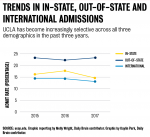With a new year comes a new bright-eyed freshman class, ready to begin new journeys. But what is changing about the incoming class of 2021? How are student admissions different from the year I was accepted? Here are a few key trends.
UCLA and UC Berkeley are becoming increasingly selective, but this year, UCLA takes the cake for the least proportion of students admitted at 16.1 percent.
Although UCLA is more selective than UC Berkeley for the Class of 2021, both campuses are getting harder to be admitted into. The number of applicants are increasing and the selection process is becoming more competitive, especially for in-state students: 84 percent of admitted Californians for UCLA’s class of 2021 will have graduated in the top 9 percent of their class.
The total admit rate for my class – the class of 2020 – was 18 percent. This made UCLA the second-most selective UC campus behind UC Berkeley, which had a total admit rate of 17.5 percent in 2016.
[Related: UCLA reaches record-low admission rate for 2015-2016 academic year]
It is becoming harder for in-state students to gain admission over out-of-state students for the Class of 2021.
The admit rate for out-of-state students has been steady, hovering around 22 to 23 percent. However, the admit rate for in-state students has fluctuated: In 2016, the in-state admit rate was 17.7 percent, but dropped to 14.6 percent in 2017. Admit rates for international students have followed a similar trend, dropping to 13.1 percent in 2017 from 14.3 percent in 2016. This means that out-of-state students were slightly more likely to get into UCLA than in-state students for the class of 2021.
This year, the University of California Board of Regents approved the UC’s first limit on out-of-state and international student enrollment, capping it at 18 percent. UCLA exceeded this amount for the 2017-2018 school year, but the school is not allowed to increase the percentage of nonresident students who make up 16.5 percent of the UC system’s 210,170 undergraduates.
Campuses want nonresident students because they diversify the student population and ring in more tuition money, but many Californians argue that admitting more nonresident students puts in-state students at a disadvantage.
[Related: Nonresidents more likely to be admitted to UCLA than in-state students]
While there is an obvious difference between in-state and out-of-state admission, there are even deeper, more subtle geographical discrepancies between the in-state Californians admitted for the 2017-2018 school year.
UCLA students are more likely to hail from certain regions of California than other regions.
For in-state freshmen California admits for the class of 2021, 30 percent were admitted from the Southern California region, 27 percent from a different Los Angeles region, 25 percent from the San Francisco Bay Area, 7 percent from the Central Valley, 6 percent from Northern California and 5 percent from the Central Coast.
The students of the Class of 2021 are some of the brightest in the face of increasingly difficult competition. UCLA beat out UC Berkeley for the most selective campus for the 2017-2018 school year, so the students admitted were from the tops of their classes. UC schools are becoming more competitive, and UCLA prospects definitely feel that pressure as the in-state acceptance rate has sunk to 14.6 percent in 2017 from 17.7 percent in 2016. Among the in-state students admitted, most are likely to come from the Southern California, Los Angeles, and San Francisco Bay Area regions.
